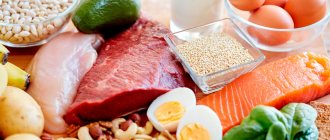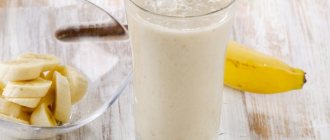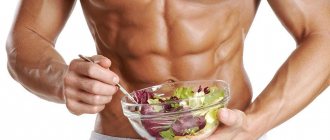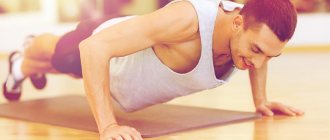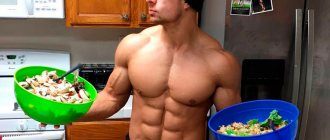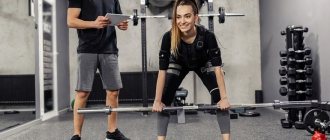Simply losing weight, when the goal is to see the lowest possible number on the scale, does not lead to anything good in terms of beauty and attractiveness. The weight is small, but the appearance wants to be better - everything hangs, sways like jellied meat and is absolutely not pleasing. What is important is not the numbers, not the thoughtless burning of fat, which exhausts muscles, sagging skin and even deteriorates health, but regular training and proper nutrition to gain muscle mass for girls.
An athletic girl weighing 60 kg who is engaged in the program looks fresher, healthier and younger than one who weighs the same, but is far from sports.
In addition, strong healthy muscles mean a slender posture, an elongated spine, and the correct arrangement of internal organs, which eliminates the occurrence of many diseases.
Thus, you need to approach both weight loss and weight gain wisely so as not to harm your body. Not the least important in the optimal formation of a figure, in addition to mandatory constant training, alternating with rest and recovery, is a compiled nutrition program and compliance with the following rules.
How much protein should you consume?
Decades of research have been conducted to calculate the right amount of protein to build muscle. Historically, most such studies have focused on men. What little research exists on differences between men and women suggests that men have a greater need for protein than women because they use more amino acids.
Because verified information about women is difficult to find, you can follow this guide exactly or modify it to suit your own needs.
As for the daily intake for girls, the main recommendations agree on 1.2-1.8 grams per kilogram of your weight daily and, judging by research, this amount is suitable for both men and women. Some people feel that consuming even more protein improves performance, but scientists have concluded that the maximum effective dosage per kg is up to 2 grams. Here are the main benefits of a high protein diet:
- Protein is more thermogenic than fats and carbohydrates, so the body will spend more energy processing it.
- It's highly filling, which helps control appetite, and protein is less likely to be stored as fat in the human body than carbohydrates and fats, even if your caloric intake is adequate.
- Protein is an energy resource that is not as important as carbohydrates and fats, but if carbohydrates and fats are poorly absorbed by the body, the body can use protein as energy.
- May prevent blood sugar spikes because it is converted into glucose much more slowly than carbohydrates.
Research suggests that the amount of muscle protein synthesized depends on the amount of protein eaten per meal - a theory known as the "muscle filling effect." Scientists have found that 20-30 grams per meal is the maximum the body can use to stimulate protein synthesis. In any case, as noted by Philips et al, 2015, these studies were conducted on people doing lower body exercises, so this theory may not apply to people doing upper body or cross-training exercises. In other words: the research is not perfect and the advice is not universal for every person, so this “limit” may not apply.
Research by Phillips et al also showed that the peak synthesis in men training whole body muscles occurred at a dosage of 0.25 grams of protein per kilogram of body weight per meal (so for the average man weighing 87 kg, this dose would be 22 grams proteins). For a woman weighing 64 kg, this is 35 grams of quality protein per meal.
Because protein synthesis slows down markedly as food is digested (3-4 hours), a smart solution is to divide your daily intake into meals to keep synthesis levels high at all times.
If you are a vegetarian, choose a protein supplement from plant sources such as pea, rice, hemp, or combine plant foods to get the full complement of amino acids from your diet.
The essential amino acid lysine, one of the BCAA amino acids found in large doses in animal protein, is considered very important in the muscle building process. Other BCAAs - valine and isoleucine - do not have the same effect. Lysine positively balances processes in the muscles, reducing muscle breakdown time and stimulating the synthesis process. The effect is similar to the effects of exercise. But the effect of lysine on the synthesis process is very short, and for a stronger effect on the synthesis process, other essential amino acids of this type will be required. We can say that lysine is the main stimulator of protein synthesis, other amino acids are its assistants. To obtain the effect of lysine, the concept of lysine strength (“lysine trigger”) was explored. Research has shown that a two-gram dose of lysine (which can be found in about 20 grams of whey) is enough to achieve benefits, but it will still depend on your body type. Getting 20-30 grams of whey protein immediately after exercise is one of the best ways to get the 2 grams of lysine you need. You can also get them from ~170 grams of chicken, turkey, lean beef, steak, salmon, white fish, tuna, which typically contain 2.5 – 2.9 grams of lysine. Other protein powders, like pea protein or hemp protein, can also be a good source of lysine. You can also take a dietary supplement that contains at least two grams of lysine and this can be taken after exercise.
General recommendations:
- Your daily protein value should be at least 117 g for a 64 kg person. women.
- Each meal should contain 25 grams of protein.
- Choose protein foods rich in lysine, getting two grams of lysine regularly, especially after strength training.
Is time important?
Our bodies stimulate muscle growth in response to strength training for 48 hours, but muscle breakdown also lasts 24 hours. After training, you have a two-day window when the body builds muscles at optimal strength, and one day when the muscle distribution is most active. Exercising with additional weights helps muscles use amino acids and promotes muscle growth, but this process can only be overcome by protein breakdown with a good nutritional system. Therefore, the first 24 hours after training are the most important.
If your goal is to build muscle, take a protein shake after exercise. Some studies suggest that consuming a pre-workout shake may even impair the muscle protein synthesis that typically occurs after a workout. Therefore, it would be more correct to plan your meals an hour before and an hour after a full workout, but taking protein immediately before, during, or immediately after exercise is unnecessary and optional.
Schoenfeld et al conducted a meta-analysis examining the effect of varying timing of protein intake in relation to exercise. In this analysis, they found that the dose itself is much more important than the timing of it, but post-workout timing is still better for fluid intake, muscle glycogen stimulation, and muscle recovery.
Overall, contrary to some very popular advice you may have heard in the past, there is likely no “anabolic window” during which you achieve maximum synthesis. Much more important is your daily nutrition, the intake of amino acids and carbohydrates before or after your workout.
About calories
As you probably already know, calories are those little devils that hide in your closet and make your clothes smaller and smaller every night. I'm joking, of course, but it's a fact that for many women, increasing their daily caloric intake is like a nightmare. Especially for those who have a history of dieting and restriction, who have spent most of their lives trying to eat as little as possible, and suddenly find out that they need an increased caloric intake in order to gain muscle. Gaining fat is a very pressing issue when we talk about nutrition for girls working out in the gym.
It's normal to gain some fat along with muscle, but fat gain will be minimal if you have the right combination of nutrition and exercise.
Adequate calorie intake affects your effectiveness in improving your figure.
Calorie deficit
When the body experiences a serious calorie deficit, muscles begin to actively disintegrate rather than be synthesized. Please note if you experience the following symptoms:
- You feel very tired after exercise, especially if you do heavy workouts.
- You constantly feel weak and dizzy.
- You don't feel like studying.
- You are constantly in a bad mood and have trouble sleeping.
You may be wondering how many women who compete in sports look impressive despite being in a calorie deficit. As you might have guessed, this is the result of losing a lot of fat and maintaining existing muscle. These women do not gain new muscle, in fact, they even lose a certain percentage of muscle, but this is not critical, because they have already achieved the desired shape before the start of deficient nutrition.
It is common for women and men bodybuilders to go through different phases before performing. At certain times they may be focused on gaining, at others they may be focused on reducing body fat percentage. Fitness models' physiques are constantly changing, so they try to eat optimally and train to improve muscle size, and then lose weight for competitions.
Calorie balance
Eating adequately, consuming exactly the amount of calories your body needs is great, but it is not ideal for gaining muscle. During periods of energy balance, protein breakdown is still quite active because there are not enough calories to support muscle growth. Even though resistance exercise will offset some of the effects of these losses, anabolic processes will still oppose the increase in muscle size.
Excess calories
But the increased number of calories perfectly stimulates muscle hypertrophy, even in the absence of strength exercises, if the daily protein intake is adequate. As you gain muscle mass, you may also see a small amount of fat gain. As expected, the percentage of fat should not be noticeable; it is often observed among both men and women trying to gain weight. Bodybuilders bulk up between performances to gain maximum volume despite little fat gain. They then restrict themselves for 12 to 16 weeks to lose fat and gain muscle.
A combination of exercise and excess calories is the best way to gain muscle and strength. If you want to minimize fat gain and you've been training for years, then you don't need to increase your calories much to start muscle growth. Research shows that people who have been involved in strength sports for a long time do not need as much excess calories as beginners. If your goal is to develop muscle, remember that your body may not be particularly lean and toned as you gain weight, because fluctuations in weight and percentage of fat and muscle are normal for all women.
How do you know you're eating enough calories?
Now you may be wondering, “How many calories should I eat? How do you find out this magic number? But there is no one answer for everyone. Everyone's metabolism is different, and energy needs vary from person to person.
Always monitor overall indicators and adjust your diet. If the weight increases by at least 300 grams per week, then everything is in order and there are enough calories. If your weight stays the same or even decreases, and at the same time your external shape becomes worse, then you need to increase the calorie content of your diet by 500 calories.
Myth 2. Strength training makes girls “pumped up”
Most women are suspicious of training with iron. If you see photos of professional CrossFit athletes , for example, you'll likely swear never to do the squat, deadlift, or military press.
BUT, this form is the result of many years of training in the gym, excellent genetics and often the use of anabolic steroids . However, in gyms you can see many girls who regularly lift barbells/dumbbells and look really big . Do you want to know what makes them like this? The answer is simple - excess fat. Look, can you call this girl “pumped”?
Of course not, right? But you might be very surprised to see how her body will change if she gains 6-7 kg of fat . After all, now she has much more muscle than the average woman (about 7 kg). Her legs will lose their slimness, the definition of her torso will disappear, and her arms will become like sausages.
You see, when you gain fat, it mostly accumulates on top and inside the muscles. Therefore, the more muscle and fat deposits you have, the more massive and shapeless your body looks .
Here is the main rule for gaining muscle mass for girls who want to be slim and sculpted:
The more muscle you have, the thinner you should be to avoid looking “pumped” (if you replace the word “pumped” with “fat”, you get a similar rule for guys).
For example, if you have very little muscle, you will look very thin with 18% body fat and feel quite comfortable with 25%. But if you have large muscle volumes, 18% is the best option , and at 25% you will be too massive.
About carbohydrates
Contrary to popular belief, there is no set requirement for daily carbohydrate intake. In reality, your body can produce the glucose (a product of carbohydrates) it needs - from amino acids and fatty acids through the process of glucogenesis. In any case, the body uses huge amounts of carbohydrates to obtain energy. Carbohydrates are stored in your muscle tissue as glycogen, which is used by your muscles during exercise to provide the energy they need.
Most of the energy your body produces (about 80 percent) comes from glycogen storage, not protein or fat. If your body is low on glycogen, such as when following a low-carb or keto diet, you may feel drowsy and weak during exercise. Some people adapt to this condition because their body has switched its primary source of energy to fat (stored in muscle tissue as triglycerides) and increased its production of energy from protein.
In any case, if you do not have carbohydrate intolerance, which is the case with diabetes or metabolic syndrome, and you are a healthy person, you do not need to exclude carbohydrates from your diet, because they play an important role in your training results.
Low carb diets still allow for muscle growth. During my training, we were told about a study of men undergoing strength training and following a low-fat, low-carbohydrate diet (less than 50 grams of carbohydrates per day). Each study subject drank a protein drink that provided them with 20 grams of whey protein and trained three times a week. The full body exercise was a challenge for every subject.
After a 12-week study, scientists found that athletes on a low-carb diet performed significantly better in terms of muscle gain, while athletes on a low-fat diet performed better in terms of fat loss. The difference in body fat may have been related to protein intake, which was better absorbed by the low-carb group, and the average age of the study participants (younger participants followed the low-carb diet). The results showed, as you may have noticed, that a low-carb diet does not have a negative effect on muscle gain. However, such a study was carried out on men, so the consequences for women are still unknown.
Table 1. Strength training program used in the study
| Day 1 (Monday) 8-10 reps 120 seconds rest | Day 2 (Wednesday) 6-7 reps 180 seconds rest | Day 3 (Friday) 8-10 reps 120 seconds rest |
| Squats | Barbell Lunge | Squats |
| Lunge with dumbbells | Leg bending/extension in the simulator | Lower block thrust |
| Bench press | Angle press | Lunges on one leg |
| Lower block thrust | Lower block thrust | Barbell row to the chin |
| Barbell row to the chin | Shoulder press | Bench press |
| Calf exercises | Calf exercises | Calf exercises |
| Abs exercise | Abs exercise | Abs exercise |
Carbohydrates have a good effect on muscle gain in interaction with the hormone insulin. This hormone delays the breakdown of protein and is considered an important stimulator of muscle growth, especially in the post-workout period. While insulin and carbohydrates do not stimulate protein synthesis, we cannot help but respond that a normal rate of synthesis (stimulated by amino acids), coupled with a reduced rate of muscle breakdown, will lead to better results.
Given that carbohydrates are one of the most important drivers of insulin secretion, they are often included in post-workout nutrition, especially if a person is training in a fasted, low-carb state. Carbohydrates also restore muscle glycogen used during exercise. Some people mistakenly believe that since insulin stops the breakdown of protein, it is necessary to cause insulin spikes with large doses of carbohydrates. Let a special contingent of gyms do this, but we do not recommend doing this.
Insulin stops muscle breakdown and makes glucose work, replenishing glycogen stores. Insulin's contribution to muscle protein balance decreases at certain levels of fasting. A normal post-exercise meal can have a positive effect within one to two hours after consumption, and depending on the size of the meal and the individual characteristics of the body, it can last up to six hours.
For example, scientists have found that a meal containing 75 grams of carbohydrates, 37 grams of protein and 17 grams of fat raises insulin concentrations within 30 minutes of eating it, and reaches a peak within an hour. The effect lasted for five hours. If you eat a large meal before your workout, your insulin levels will still remain high. Therefore, the need to quickly slow down the breakdown of muscle protein with protein stimulation will only be necessary if you prefer to exercise on an empty stomach.
Another thing about insulin is that many people forget that whey protein stimulates insulin secretion. Therefore, milk or whey protein alone can increase the level of synthesis and slow down muscle breakdown.
Including carbohydrates in your post-workout meal will help replenish glycogen used during exercise. Carbohydrates provide the body with glucose, which is stored in the muscles in the form of glycogen, and insulin sends all the glucose to them.
How many carbohydrates do you need daily? According to Schoenfeld, in studies conducted mostly on men, there is only an average requirement for carbohydrates during exercise for muscle hypertrophy. It's not yet entirely clear exactly how many carbohydrates you need to achieve maximum results, but 3 grams per kilogram daily is a good start. For a woman weighing 64 kg, that's 190 grams of carbohydrates daily (approximately 763 kcal) from foods such as grains, potatoes, vegetables, fruits and by-product carbohydrates from protein foods. For women with a calorie surplus, this strategy is quite suitable.
Jeff Volek, Ph.D., and I wrote a paper in 2006 showing that women do not store glycogen in the same amount as men in response to the same intake of carbohydrates. And at the moment it is not entirely clear how exactly carbohydrates affect muscle hypertrophy among women. Also, some women (especially bodybuilders) have an increased insulin response to carbohydrates and will need less of them. Every woman's needs are different and she must listen to her body to achieve the ideal nutrition for her results.
The menstrual cycle also affects the body's response to various macronutrients. In the first 14 days of the cycle, a woman's body will use and respond better to the intake of carbohydrates. In the last 14 days, her body will rely more on dietary fats. Therefore, it will be useful to use your cycle to control your carbohydrate intake.
In general, some women can achieve better results by consuming less than 3 grams per kilogram of body weight per day for a few days a couple of times a month. Listen to your body, experiment and don't forget that no two people are alike.
Women's motivation
As I wrote above, the beauty of a girl is a sign of her success under the conditions of natural selection. This speaks about her health, her ability to give birth to healthy offspring, as well as her adaptability to environmental conditions.
It's no wonder that all girls want to be beautiful. No matter what anyone tells you, every girl dreams of a sexy body and attention from men.
Women's motivation is an amazing thing. She is able to help them endure colossal loads, but, like any human body, girls are also susceptible to laziness, because... the brain tries to minimize energy expenditure. But physical, muscular activity requires a lot of it, and is not beneficial to the body.
This is where this strange paradox comes from. Girls want to be beautiful, but, in most cases, they do the wrong thing. They spend hours twirling hula hoops, kicking their legs in all directions with bandages on their foreheads, going to step classes, oxy-size classes and other ineffective activities.
At the same time, their appearance remains unchanged for years and then, without losing a single gram of fat, they give up this useless activity. After all: “I tried, but apparently that’s just my constitution.”
What could be more logical: to get a beautiful body, you need to remove excess fat, and then, when you don’t look like a chocolate-covered candy, look at your problem areas and build up muscles in the right places.
All! But no. I want to be sexy, but I don’t want to strain my butt for this. And not only the fifth point. After all, you will have to control your nutrition, really train, and not think that you are training.
But girls are not always to blame. On every corner, as well as the entire Internet, various completely useless state-of-the-art products for instant weight loss and muscle building are flooded. And a person wants to believe that he will spend a minimum of energy and get the maximum result.
That’s why various belts, teas and coffees for weight loss, bracelets for “unreal” muscle pumping that allow you to eat everything and lose weight, meal replacements, etc. appear.
After all, it’s profitable! Manufacturers earn millions from their products. More precisely on human laziness. How much you give is how much you receive. I talked about this in my cool article: “How to get pumped in a week.”
Various myths about bodybuilding also add fuel to the fire. Photos of masculine women have flooded the World Wide Web. Girls are afraid of becoming like men and losing their main criterion for success - beauty.
As a result, it turns out that there is desire and motivation, but the path to achieving the goal is completely crazy. There is no clear understanding of the correct, most effective training.
As a result, due to the lack of results, motivation disappears, and girls give up their studies without any hope, because we do not like to invest energy in something that does not bring results. This applies to all areas of our lives.
Women's motivation comes from the desire to produce offspring more adapted to environmental conditions, and for this they need the best man, with excellent genes and good support resources, to ensure better survival for their child.
To get the best man, you need to have a highly competitive resource, which for women is their beauty. No need for illusions.
A man’s success can be measured by other indicators (for example, the amount of money in his account), but if a girl is not beautiful, then it will be very difficult for her to attract a worthy man.
Taking creatine
We'll finish by talking about the dietary supplement creatine, which is often taken during strength training.
While there is plenty of research on creatine, as you might expect, research in women is virtually non-existent. What little information we have available proves that creatine can help women build muscle, too.
In the latest women's study, researchers examined the effects of creatine supplementation on muscle strength and body composition with strength training. Nineteen sedentary women were divided into two groups: 10 took 20 grams of creatine daily and 9 took a placebo for five days, then tapered to 5 grams over 10 weeks.
The researchers found that after ten weeks, the group taking creatine performed 20 to 25 percent better in lower body exercises than the placebo group. More interestingly, they noted that muscle and lean tissue increased significantly in the creatine group. Overall, all of the sedentary women were able to increase their strength and improve their body composition through strength training with the help of supplements. Therefore, creatine is a great addition to your diet if you are looking to increase your strength and gain mass.
Myth 3. Girls need to “keep themselves in good shape” and not build muscles
On the Internet and women's magazines you can find a lot of “useful” advice on how to “maintain tone.” To do this you need to starve yourself , do a ton of cardio and lift light weights.
Well, if you want to be tired and hungry all the time, hate your workouts and constantly think about a piece of cake (which will only increase the volume of subcutaneous fat), I have no objection. However, you can choose a different path, which includes proper nutrition and proper training. Let's look at it with an example. Look at these photos:
What kind of body would you like? Most likely, the second one. But you will be surprised when I tell you that these girls have approximately the same body fat percentage . The latter simply has the right muscles.
As I mentioned earlier, muscle is what gives you shape, curves and “tone” (tautness) at a low percentage of body fat. If you don't have enough muscle, you'll just be skinny.
The question arises: how much muscle do you need ? Most girls need to gain about 5-10 kg of muscle their body fat percentage to 18-20% - and they will get the reflection in the mirror that they want.
Having achieved such indicators, you will look feminine and sporty . This physical fitness can be maintained all year round.
So, we have dispelled the myths that surround gaining muscle mass for girls and understood where we need to move. But what exactly needs to be done ? Let's figure it out.
Briefly about the basics
So, now you have a better understanding of the processes of your body: you understand the structure of muscles and nutritional characteristics during strength training. For best results, follow these quick guidelines:
- Try to eat the right amount of protein daily, with each meal, you can consume supplements, for example, whey protein.
- Monitor your caloric intake; it will be preferable if it is higher than your norm.
- Choose natural sources of carbohydrates to replenish muscle glycogen and prevent muscle protein breakdown.
- Add 3-5 grams of creatine to your diet daily.
One thing I also want to get across to you is that while nutrition is important for muscle growth, the most important part of it is strength training. You can't gain muscle without exercising. So, go ahead, pull the barbell and watch your muscles grow!
The Best Muscle Gaining Tips for Women
We will tell you how to achieve the athletic body you have long dreamed of, without much effort. Intriguing? So let's get started!
It is known that the maximum strength of female muscles is approximately half of that of men. This is due to the fact that testosterone levels in women are much lower, and the hormone is necessary for gaining muscle mass.
How to achieve an athletic, toned body
Eat well and make sure you're getting all the nutrients you need for muscle growth. And don't forget about strength training - the most important thing when gaining muscle.
Don't overload, let your body rest. You don't have to practice every day to make progress. By choosing the right program, women can gain about a kilogram of muscle per month!
With the help of our guidance and your persistence, you can achieve better results. The most important thing for you to do is develop a lesson plan.
But first, it will be useful to understand your diet, which is no less important for muscle growth.
The meal plan below is perfect for the average woman to get all the nutrients she needs to gain muscle without the excess fat, because we know you want to gain muscle while staying lean. This plan will be a great help to you in this matter.
Home workouts
You can also train effectively at home, but for this you need to purchase equipment. All of the listed exercises can be adapted for home use, or you can select analogues that work the same muscle groups. At a minimum, for home workouts you need dumbbells and leg weights. It would be a good idea to purchase a set of fitness bands.
The downside of home training is a significant decrease in motivation compared to the gym, and the need for strict self-discipline. As practice shows, it is easier to work out in the gym, and this is not only due to the large selection of exercise equipment and sports equipment, but also to the general atmosphere. The best solution for every result-oriented woman is to work with a personal trainer.
Daily nutrition plan for women
There are thousands of meal plans you can make to fit your plan, but if you don't know where to start, here are some ideas. Of course, this is just a rough plan and you can change it as you wish.
Breakfast
- Oatmeal with peanut butter
- Fruit
- Some nuts as a source of protein
- Protein smoothie
Snack
Dinner
- Sandwich with chicken, cabbage and tomatoes
- Salad with tuna
- Fruits and vegetables
Snack before workout
- Nuts and seeds for energy and protein
- Dates or other dried fruits for carbohydrates (energy)
Dinner (after training)
- Brown rice fried with chicken or beef with vegetables
- Smoothie with milk and protein
- green leaves
Snack before bed
- Cottage cheese with fruit
Sample diet for a week
Any of the products on this menu can always be replaced with your favorite, which will be similar in calorie content and protein and carbohydrate content. For example, chicken breast can be replaced with turkey, and quinoa can be replaced with buckwheat or rice.
| Monday | Breakfast | 6 egg whites, salsa, 1 teaspoon olive oil, 1 banana, 1 piece whole grain bread. |
| Snack | 125 g Greek yogurt, 250 g blueberries, 2 teaspoons flax seeds | |
| Dinner | 170 g chicken breast, 1 small whole grain tortilla, vegetables, 1 teaspoon olive oil, salad dressing, 1 orange | |
| Snack | 1 tablespoon protein powder, 1 apple, 10 almonds | |
| Dinner | 170g Low-fat steak, 5 servings asparagus, 1 sweet potato, 1 teaspoon olive oil, 1 teaspoon lemon juice. | |
| Snack | 125 g. Low-fat cottage cheese, 1 teaspoon of peanut butter without additives. | |
| Tuesday | Breakfast | 6 egg whites, salsa, 2 slices whole grain bread, 1 teaspoon peanut butter, 1 banana. |
| Snack | 1 can of tuna, greens and carrots, 30 g of Cheddar, 1 slice of whole grain bread. | |
| Dinner | 170 g Turkey breast, 200 g boiled rice, steamed broccoli, 10 almonds | |
| Snack | 1 tablespoon protein powder, 2 kiwis, 20 pistachios | |
| Dinner | 140 g Salmon, 400 g Steamed broccoli, 1 small potato tuber. | |
| Snack | 125 g. Cottage cheese, 2 teaspoons flaxseed | |
| Wednesday | Breakfast | 225 g. Cottage cheese, 100 g. Blueberries, 30 g. Bran flakes, 2 teaspoons chopped almonds |
| Snack | 1 tablespoon protein powder, 1 orange, 10 almonds | |
| Dinner | 1 can of tuna, 200 g. Boiled brown rice, salsa sauce, chopped peppers, carrots and onions. | |
| Snack | 2 hard-boiled eggs, 1 apple, carrot and celery sticks | |
| Dinner | 170 g cod, steamed white cabbage, 200 g boiled quinoa, 30 g cheddar | |
| Snack | 225 g Greek yogurt, 2 teaspoons flax seeds | |
| Thursday | Breakfast | 3 turkey sausages, 40 g dry oatmeal, half a grapefruit |
| Snack | 225 g cottage cheese, 1 banana, 1 teaspoon peanut butter | |
| Dinner | 170 g chicken breast, 200 g cooked whole grain pasta, 115 g tomato sauce, chopped vegetables to taste | |
| Snack | 1 tablespoon protein powder, 1 apple, 20 almonds | |
| Dinner | 170g steak, 250g steamed broccoli, 1 large sweet potato, 30g cheddar | |
| Snack | 250 g skim milk, 1 apple | |
| Friday | Breakfast | 1 egg, 35 g bran flakes, 250 g milk, 10 almonds , 100 g grapes |
| Snack | 250 g low-fat yogurt, 100 g blueberries, 2 teaspoons chopped almonds | |
| Dinner | 170 g chicken breast, 1 small whole grain pita, celery, onion, pepper, mushrooms, 1 apple | |
| Snack | 1 can tuna, 175 g corn, 2 small pieces of avocado | |
| Dinner | 170 turkey breasts, 120 g brown rice, 250 g vegetables, 1 teaspoon dressing | |
| Snack | 225 g cottage cheese, 1 teaspoon peanut butter | |
| Saturday | Breakfast | 6 egg whites, 1 orange, salsa, chopped vegetables, 1 teaspoon olive oil, 1 slice of whole grain bread. |
| Snack | ½ jar of salmon mixed with low-fat mayonnaise, celery sticks, 5 whole grain crackers | |
| Dinner | 6 pieces of low-fat chicken, 500 grams of mixed vegetables, 1 teaspoon of salad dressing, 2 slices of whole grain bread. | |
| Snack | 225 g low-fat yogurt, 100 g strawberries, 2 teaspoons flax seeds. | |
| Dinner | 170 g chicken breast, 120 g brown rice, 250 g steamed broccoli, 10 almonds | |
| Snack | 125 g Greek yogurt, 1 peach | |
| Sunday | Breakfast | 6 egg whites, 30 g low-fat cheddar, 2 slices whole grain bread, chopped vegetables |
| Snack | 1 tablespoon protein powder, 1 orange, 8 cashews | |
| Dinner | 1 can tuna mixed with onion and low-fat mayonnaise, 1 small whole grain tortilla, 1 banana | |
| Snack | 225 g cottage cheese, 225 g fruit in light syrup, 20 almonds | |
| Dinner | Any dish, but do not overdo it with the portion | |
| Snack | 250 g Greek yogurt, 2 teaspoons flax seeds. |
Lentils
High protein content is one of the benefits of lentils. Half a glass of this culture contains about nine grams of protein, the necessary potassium and phosphorus, as well as nicotinic and folic acids. The product lowers blood pressure.
This material is for informational purposes only. You can learn more about a healthy lifestyle and ways to prevent excess weight from our general practitioner. Contact him by phone 8 (495) 356 3003 at a convenient time.
Innovative Technologies LLC thanks you for reading the information.
Muscle Gaining Exercise Plan for Women
Heavy deadlift exercises should be a priority when it comes to building strength and gaining muscle. Light weights will do the opposite of your goal, and we want to gain muscle, right? Therefore, every workout you should lift heavy weights, making it heavier each time.
The complex presented below will help you with this.
Lifting heavy weights will put a lot of stress on your central nervous system. If you don't allow yourself to rest between sessions, you'll soon become seriously fatigued from your workouts and find yourself taking two steps back for every step forward.
Try to choose the heaviest weight possible when performing exercises.
When you do strength training, you need to rest more than during normal training, don't forget about it. That's why our lesson plan uses a three-day structure. It will allow your body to have a good rest outside the gym, recover and consolidate the results. Also make sure you are consuming enough calories to build and repair muscle.
You can use this set of exercises for classes on Monday/Wednesday/Friday or Tuesday/Thursday/Saturday.
When doing strength training, keep cardio to a minimum, as it can hide your progress.
If you do cardio to improve or maintain your health, reduce the intensity to a low-intensity 20-minute session on Sunday.
Table: Set of exercises
| Day 1 | Repetitions | Approaches | Rest |
| Bench press | 5 | 5 | 3 min |
| Squats | 5 | 5 | 3 min |
| Lifting the barbell | 5 | 5 | 3 min |
| Ab exercises | 3 | 6 | 2 minutes |
| Barbell curl | 2 | 8 | 90 sec |
| French press | 2 | 8 | 90 sec |
| Bench press | 2 | 8 | 30 sec |
| Day 2 | Repetitions | Approaches | Rest |
| Chest press | 5 | 5 | 3 min |
| Deadlift | 5 | 5 | 3 min |
| Pull from above | 5 | 5 | 3 min |
| Lunges | 3 | 6 | 3 min |
| Push ups | 3 | 8 | 90 sec |
| Front press | 3 | 8 | 90 sec |
| Weight-bearing exercises for legs | 2 | 8 | 30 sec |
| Day 3 | Repetitions | Approaches | Rest |
| Pull from above | 5 | 5 | 3 min |
| Squats | 5 | 5 | 3 min |
| Horizontal thrust | 5 | 5 | 3 min |
| Leg extensions | 3 | 8 | 2 minutes |
| Hamstring Curls | 3 | 8 | 90 sec |
| Seated calf raises | 2 | 8 | 90 sec |
| Plank | 1 | 8 | 30 sec |

